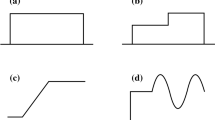Abstract
A probability model for the amplitude of the first neural component,N 1, of the click response has been developed on the assumption thatN 1 is the summated effect of practically simultaneous firing from large numbers of independent neural units. Equations derived from the model predict the course of recovery for the response to the second of two clicks. A mathematical relation is shown between the two-click situation and the intensity growth curve for the first neural component of the response to a single click. This permits indirect reconstruction of the function relating amplitude ofN 1 to stimulus intensity. Experiments with pairs of clicks indicate that a normal probability integral provides a satisfactory fit. Thus the entire intensity function ofN 1 is capable of specification in terms of two statistical parameters, the mean and the standard deviation of the normal integral. Factors that affect the click response are presumed to act upon these parameters.
Similar content being viewed by others
Literature
von Brücke, E. T., M. Early, and A. Forbes. 1941. “Fatigue and refractoriness in nerve.”Jour. Neurophysiol.,4, 456–472.
Crozier, W. J. 1940. “On the law for minimal discrimination of intensities. IV. ΔI as a function of intensity.”Proc. Nat. Acad. Sci.,26, 382–89.
Davis, H., B. E. Gernandt, and J. S. Riesco-MacClure. 1950. “Threshold of action potentials in ear of guinea pig.”Jour. Neurophysiol. 13, 73–87.
Kahana, L., W. A. Rosenblith, and R. Galambos. 1950. “Effect of temperature change on the round window response in the hamster.”Amer. Jour. Physiol.,163, 213–23.
Lorente de Nó, R. 1947.A Study of Nerve Physiology, Vol. 2. New York: The Rockefeller Institute for Medical Research.
Pecher, C. R. 1939. “La fluctuation d'excitabilité de la fibre nerveuse.”Arch. Internat. Physiol.,49, 129–52.
Rosenblith, W. A. 1950. “Auditory masking and fatigue.”Jour. Acoust. Soc. Amer.,22, 792–800.
Rosenzweig, M. R., and W. A. Rosenblith. 1950. “Some electrophysiological correlates of the perception of successive clicks.”Jour. Acoust. Soc. Amer.,22, 878–80.
Author information
Authors and Affiliations
Additional information
This research was carried out under Contract N5ori-76 between Harvard University and the Office of Naval Research, U. S. Navy (Project Nr142-201, Report PNR-107). Reproduction for any purpose by the U. S. Government is permitted.
Rights and permissions
About this article
Cite this article
McGill, W.J., Rosenblith, W.A. Electrical responses to two clicks: A simple statistical interpretation. Bulletin of Mathematical Biophysics 13, 69–77 (1951). https://doi.org/10.1007/BF02478353
Issue Date:
DOI: https://doi.org/10.1007/BF02478353




